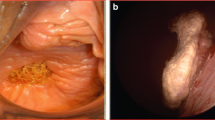Abstract
Introduction and hypothesis
We evaluated whether the use of estrogen vaginally prior to synthetic midurethral sling insertion mediates the risk of mesh exposure. A secondary aim was to evaluate other factors that may be associated with mesh exposure.
Methods
We performed a retrospective cohort study of patients undergoing midurethral sling insertion from January to December 2010 within the Southern California Permanente Medical Group. Women who used estrogen vaginally prior to surgery were classified as those who filled a prescription between 1 and 45 days before surgery or whose medical records indicated its use at the time of preoperative evaluation. Logistic regression analysis was used to calculate odds ratios (OR) and 95 % confidence intervals (CI) for factors associated with mesh exposure while controlling for confounding variables.
Results
A total of 1544 patients met inclusion criteria, of whom 248 (16.1 %) used estrogen vaginally prior to surgery. Mean age was 53.7 years (range 27–89). Thirty-seven (2.4 %) women were diagnosed with mesh exposure, of whom 19 underwent surgical reoperation. In multivariate logistic regression analysis, preoperative use of estrogen vaginally was not associated with the risk of mesh exposure (OR 0.79, CI 0.26–2.38, p = 0.67). Age, body mass index, menopausal status, use of hormone replacement therapy, smoking status, and diabetes were not associated with risk of mesh exposure.
Conclusions
Preoperative use of estrogen vaginally did not appear to mediate the risk of mesh exposure following midurethral sling placement in this cohort.
Similar content being viewed by others
References
Wu JM, Matthews CA, Conover MM, Pate V, Jonsson Funk M (2014) Lifetime risk of stress urinary incontinence or pelvic organ prolapse surgery. Obstet Gynecol 123(6):1201–1206. doi:10.1097/AOG.0000000000000286
Nager C, Tulikangas P, Miller D, Rovner E, Goldman H (2014) Position statement on mesh midurethral slings for stress urinary incontinence. Female Pelvic Med Reconstr Surg 20(3):123–125. doi:10.1097/spv.0000000000000097
Nguyen JN, Jakus-Waldman SM, Walter AJ, White T, Menefee SA (2012) Perioperative complications and reoperations after incontinence and prolapse surgeries using prosthetic implants. Obstet Gynecol 119(3):539–546. doi:10.1097/AOG.0b013e3182479283
Song PH, Kim YD, Kim HT, Lim HS, Hyun CH, Seo JH, Yoo ES, Park CH, Jung HC, Gomelsky A (2009) The 7-year outcome of the tension-free vaginal tape procedure for treating female stress urinary incontinence. BJU Int 104(8):1113–1117. doi:10.1111/j.1464-410X.2009.08504.x
Suskind AM, Kaufman SR, Dunn RL, Stoffel JT, Clemens JQ, Hollenbeck BK (2013) Population-based trends in ambulatory surgery for urinary incontinence. Int Urogynecol J 24(2):207–211. doi:10.1007/s00192-012-1823-y
Takacs P, Zhang Y, Jaramillo S, Bardawil T, Candiotti K, Medina CA (2010) The effects of estrogen, progesterone and polypropylene mesh on vaginal smooth muscle cell proliferation. J Smooth Muscle Res 46(1):9–15
Sirls LT, McLennan GP, Killinger KA, Boura JA, Fischer M, Nagaraju P, Peters K (2013) Exploring predictors of mesh exposure after vaginal prolapse repair. Female Pelvic Med Reconstr Surg 19(4):206–209. doi:10.1097/SPV.0b013e318298b381
Rahn DD, Ward RM, Sanses TV, Carberry C, Mamik MM, Meriwether KV, Olivera CK, Abed H, Balk EM, Murphy M, Society of Gynecologic Surgeons Systematic Review G (2015) Vaginal estrogen use in postmenopausal women with pelvic floor disorders: systematic review and practice guidelines. Int Urogynecol J 26(1):3–13. doi:10.1007/s00192-014-2554-z
Harris PA, Taylor R, Thielke R, Payne J, Gonzalez N, Conde JG (2009) Research electronic data capture (REDCap)--a metadata-driven methodology and workflow process for providing translational research informatics support. J Biomed Inform 42(2):377–381. doi:10.1016/j.jbi.2008.08.010
Acknowledgments
The authors thank Jeffrey M. Slezak, MS, of the Southern California Permanente Medical Group Department of Research and Evaluation for his help with statistical analysis.
Conflict of interest
None.
Author information
Authors and Affiliations
Corresponding author
Additional information
Brief summary
Preoperative exposure to vaginally applied estrogen was not associated with mesh exposure following midurethral sling placement, and there was no association with other factors.
Rights and permissions
About this article
Cite this article
Cadish, L.A., West, E.H., Sisto, J. et al. Preoperative vaginal estrogen and midurethral sling exposure: a retrospective cohort study. Int Urogynecol J 27, 413–417 (2016). https://doi.org/10.1007/s00192-015-2810-x
Received:
Accepted:
Published:
Issue Date:
DOI: https://doi.org/10.1007/s00192-015-2810-x




